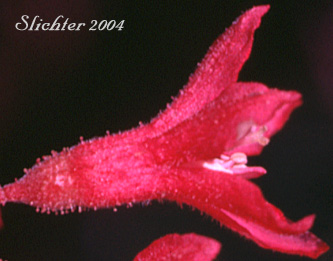 Characteristics:
Characteristics:
The red-flowering currant is an attractive erect, upland deciduous shrub from 1-3 meters high. The branches are reddish brown and covered with fine hairs. The leaves alternate on the branches and are palmately-veined. The blade has 3-5 rounded lobes, and the margins are double-toothed. The blades measure 3-9 cm across and are usually wider than long. The base of the leaf is cordate and the surface of the leaves is deeply wrinkled.
The arching or drooping racemes are 10-25 flowered. Individual flowers are about 9-15 mm long and a bright pink or red in color. The calyx is tubular-cylindrical and red, with 5 spreading sepals.. The 5 petals are each spatulate or wedge-shaped and may be red or white and on the same axis as the tube. The fruit is blue-black in color with a white bloom.
1. The berries are edible dried or raw, and they may be used in jams or wine.
2. It is host to white pine rust, a fungal disease which may kill many pines. Many red-flowering currants have been eliminated for this reason.
3. The leaves are browsed by many herbivores and the berries are consumed by many small mammals or birds. The flower may attract early season hummingbirds looking for nectar.
Red-flowering currant is found in dry, open woods near wetlands. It is generally shade-intolerant.
Red-flowering currant may be found from British Columbia south to the Coast Range of California south of San Francisco. It is found from the east slope of the Cascades westward to the coast in Washington and Oregon, but only west of the Cascades and Sierra Nevada to the south.